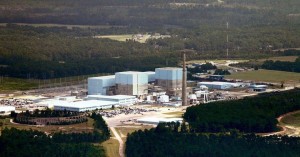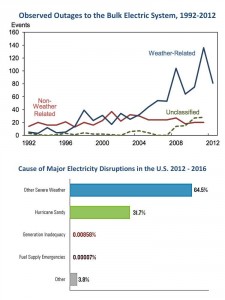Hurricane Florence No Problem For Nuclear Power Plants
Hurricane Florence, a potentially devastating Category 2 hurricane is on track to make landfall in the Carolinas sometime within 24 hours after this morning, Thursday, September 13. With winds up to 130 miles per hour, Florence could be the most powerful storm to hit so far north in the United States - ever.
Unfortunately, Tropical Storm Isaac, and Hurricane Helene are fast on her heels (see figure). Isaac is expected to upgrade to a hurricane before landfall.
Along with most everyone else, nuclear power plants in North and South Carolina, as well as Virginia, have been preparing for the natural onslaught.

The Brunswick Nuclear Power Plant, two miles north of Southport, North Carolina will get a direct hit by Hurricane Florence. But there's no worry as nuclear plants are the most resistant to severe weather of all energy sources. The plant produces over 15 billion kWhs a year and provides power to over 4 million people. DOC SEARLS
The United States Nuclear Regulatory Commission (NRC) is watching carefully. But no one is really worried that much will happen, contrary to lots of antinuclear fearmongering. Power outages will occur as lines and transformers are destroyed and non-nuclear buildings get damaged, and it might takes a few days to a few weeks to bring power back up, something that includes all energy sources.
'We anticipate Hurricane Florence to be an historic storm that will impact all customers,' said Grace Rountree, a spokeswoman for Duke. These reactors provide power to about 4 million customers in the two Carolinas.
The Brunswick plant has withstood several hurricanes since the two reactors there began operation in the mid-1970s, including Category 3 Hurricane Diana in 1984 and Category 3 Hurricane Fran in 1996. Category 4 Hurricane Hugo, the most often-compared with Florence, made landfall about 150 miles southwest of Brunswick in South Carolina in 1989.
The NRC has overseen all American nuclear plants as they've beefed up safety equipment and disaster response, including portable pumps and generators, following the accident at the Fukushima nuclear plant in Japan in 2011. This week, nuclear operators have made sure that backup diesel generators have enough fuel, have secured loose equipment and materials that could become wind-borne projectiles, and have emergency response vehicles and personnel ready.
Following protocols, the reactors at the nuclear plants have started shutting down before the hurricane is scheduled to arrive. While all nuclear reactors are protected against extreme winds, including tornado-strength gusts up to 300 mph, they shut down as a protective measure.
Food, water and other necessities are kept onsite at these nuclear plants to prepare for potential isolation of the site, and staff needed during the storm are brought in to ensure proper resources are available for an extended period.
The Carolinas have a heavy concentration of power reactors - 12 of the country's 99 reactors. Four more reactors are in Virginia and five are in coastal Delaware and Maryland. These reactors provide enough electricity to power 30 cities the size of Raleigh.

Weather-related disruptions of our electrical grid have become the dominant disturbances over the last 20 years, especially in the last several. This has resulted from an increase in extreme weather and an increasingly aging energy infrastructure, most of which is over 40 years old. The costs for these storms over the last ten years have exceeded $400 billion. EIA AND RHODIUM GROUP
Nuclear is the only energy source immune to all extreme weather events - by design. Plants have steel-reinforced concrete containments with over 4-foot thick walls. The buildings housing the reactors, vital equipment and used fuel have steel-reinforced concrete walls up to 7 feet thick, which are built to withstand any category hurricane or tornado. They can even withstand a plane flying directly into them.
Not so for many other parts of our power systems. Weather-related disruptions of our electrical grid have become the dominant disturbances over the last 20 years, especially in the last several (see figure). This has resulted from an increase in extreme weather plus an increasingly aging energy infrastructure, most of which is over 40 years old. Some pipelines have passed 100 years.
The costs for these storms over the last ten years have exceeded $400 billion. Fortunately, the nuclear industry has kept up its infrastructure better than any other industry except perhaps high-speed communications.
Last year, when Hurricane Irma made landfall in Florida in early September, Florida Power & Light shut three of the four nuclear reactors at its Turkey Point and St. Lucie nuclear plants in southern Florida. Texas nuclear plants weathered Hurricane Harvey easily as well.
Last summer, a heat wave cooked America with extreme temperatures, affecting most energy production as well as causing fires and water shortages, sucking electricity like crazy to power the cooling necessary to avoid discomfort and even death. According to the National Weather Service, 122 million Americans were under heat alerts.
Fortunately, nuclear power didn't mind, scoring record capacity factors of 96% and up, with no increase in price. Other energy sources did not fare so well and some gas plants gouged consumers just because they could.
In 2014, a Polar Vortex shut down natural gas and coal plants, and stopped wind turbines and solar generation. But nuclear performed wonderfully and provided more power to the hard-hit northeast than any other source.
Whether it's hurricanes, floods, earthquakes, heat waves or severe cold, nuclear performs more reliably than anything else. There's no better reason to retain our nuclear fleet, and even expand it, to give us a diverse energy mix that can handle any natural disaster that can occur.
This article originally appeared on Forbes.
Feel free to leave a constructive remark or question for the author in the comment section below.

